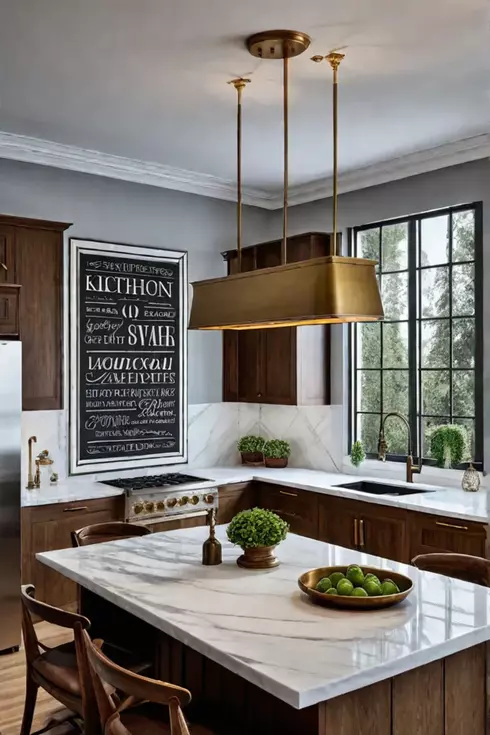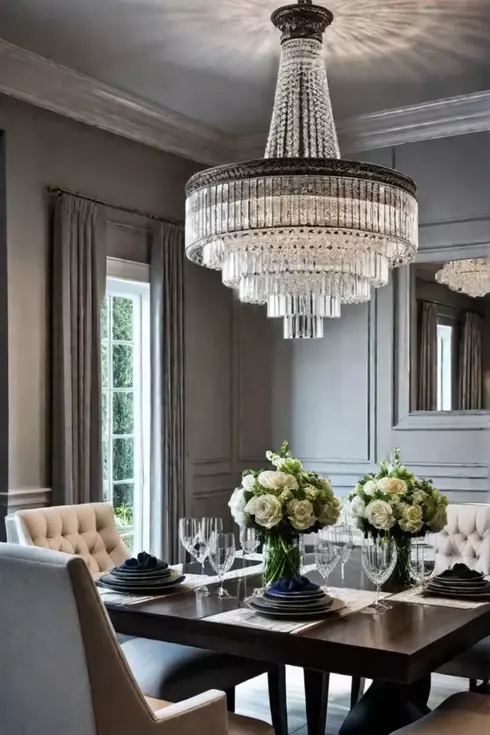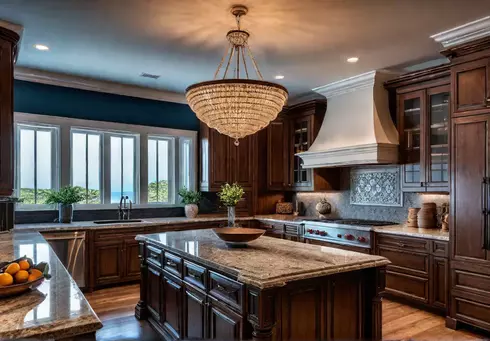Imagine entering a cozy, inviting kitchen where warm, ambient lighting envelops you like a gentle hug. The soft glow of a chandelier casts a warm, inviting ambiance, while strategically placed pendant lights and sconces highlight the intricate details of your traditional cabinetry and architectural elements. This harmonious lighting balance is the secret to creating a timeless and utterly captivating kitchen.
As a home decor enthusiast, you know lighting is the unsung hero of interior design. It can transform a space from merely functional to an immersive, multi-sensory experience. In a traditional kitchen, where every detail is thoughtfully curated to evoke a sense of nostalgia and comfort, lighting plays a pivotal role in setting the mood and bringing the entire design vision to life.

So, let’s embark on a journey to unlock the secrets of illuminating your traditional kitchen with style, warmth, and purpose.
Chandeliers: The Crowning Glory
Imagine a grand, crystal chandelier cascading from the ceiling, its intricate design catching and refracting light in a mesmerizing dance. This opulent centerpiece adds a touch of elegance and serves as the anchor for your entire lighting scheme.
When selecting a chandelier for your traditional kitchen, consider the size and style that will best complement the room’s architecture. A chandelier that is too small can get lost in the space, while one that is too large may overwhelm the room’s proportions. Opt for a design that echoes the overall aesthetic of your kitchen, whether it’s a classic, ornate piece or a more contemporary interpretation with clean lines and minimalist flair.

But a chandelier’s role extends beyond mere aesthetics. Strategically placed above a dining table or kitchen island, it can create a cozy, inviting atmosphere for family meals and gatherings. By layering the chandelier’s illumination with other lighting sources, such as recessed lighting or pendant lights, you can achieve a balanced, inviting ambiance that feels cohesive and visually interesting.
Pendant Lights: Functional Flair
Pendant lights are the versatile workhorses of traditional kitchen lighting. They provide task lighting for food preparation and dining areas and add a decorative touch that can elevate the entire space.
When selecting pendant lights, consider the style, size, and placement that best enhance your kitchen’s design. For a classic look, opt for pendant lights with intricate metalwork or stained glass accents. Alternatively, you can embrace a more modern interpretation with sleek, geometric shapes or industrial-inspired designs.

Pendant lights can layer lighting and create a cohesive look throughout your traditional kitchen. For example, pendant lights above a kitchen island can be paired with under-cabinet lighting to provide a balanced and inviting ambiance. You can also create a stunning focal point by clustering multiple pendant lights over a dining table or breakfast nook.
Recessed Lighting: The Discreet Illuminator
Recessed lighting is the unsung hero of traditional kitchen design. These discreet yet efficient fixtures can be seamlessly integrated into your ceiling, providing overall illumination while allowing your kitchen’s architectural features and decor to take center stage.
When planning your recessed lighting layout, consider the placement and spacing of the fixtures to ensure even and effective illumination throughout the space. Pay attention to areas requiring additional task lighting, such as workspaces or reading nooks, and adjust the placement accordingly.

The evolution of recessed lighting technology has also opened up a world of possibilities. From energy-efficient LED bulbs to adjustable trim styles and finishes, you can tailor your recessed lighting to complement your traditional kitchen’s aesthetic while maximizing functionality perfectly.
Under-Cabinet Lighting: Illuminating the Details
Under-cabinet lighting is a practical and transformative element in traditional kitchen design. It improves task lighting for food preparation and cooking and adds depth and dimension to the space by highlighting the intricate details of the cabinetry and countertops.
When selecting under-cabinet lighting, consider the type of bulb, color temperature, and placement that best suits your needs. Warm, soft lighting can create a cozy and inviting atmosphere, while cooler tones may be better suited for task-oriented areas.

One of the most significant benefits of under-cabinet lighting is its ability to create a warm and inviting atmosphere in your traditional kitchen. By strategically placing lights under cabinets and along countertops, you can make a cozy, functional space that feels visually appealing and practical.
Sconces: Decorative Illumination
Sconces are the versatile chameleons of traditional kitchen lighting. These wall-mounted fixtures can serve decorative and functional purposes, adding depth and dimension to your space while providing ambient or task lighting where needed.
When selecting sconces for your traditional kitchen, consider the style and placement that best complement the overall design. Opt for sconces with intricate metalwork or stained glass accents to add a touch of vintage charm, or choose sleek, contemporary designs for a more modern twist.

Sconces can highlight architectural features, such as archways or decorative moldings, or create a specific mood in the space. For example, placing sconces above a kitchen fireplace or on either side of a decorative range hood can create a warm and inviting focal point.
Layering Lighting: The Art of Ambiance
The true magic of traditional kitchen lighting lies in the art of layering. By combining and coordinating various lighting elements, you can create a cohesive and visually interesting lighting scheme that enhances the functionality and ambiance of your space.
Imagine the warm glow of a chandelier casting a soft, ambient light throughout the room while pendant lights provide task lighting over the kitchen island. Recessed lighting fills in any dark corners, and under-cabinet lighting highlights the intricate details of your cabinetry. Finally, strategically placed sconces add depth and dimension, creating a layered and dynamic lighting experience.

When layering lighting, consider the overall balance and harmony of the space. Experiment with different combinations of lighting sources, adjusting their intensity and placement until you achieve the desired ambiance. Remember, the key is to create a cohesive and visually appealing lighting scheme that enhances the functionality and ambiance of your traditional kitchen.
Choosing Fixtures: Balancing Aesthetics and Functionality
When selecting lighting fixtures for your traditional kitchen, it’s crucial to balance aesthetics, functionality, and energy efficiency. Consider your kitchen’s overall design aesthetic when choosing fixtures, as well as the space’s specific needs in terms of task lighting and overall illumination.
The evolution of lighting fixture styles and materials has opened up a world of possibilities for traditional kitchen design. From ornate crystal chandeliers to sleek metal pendant lights, countless choices suit any aesthetic preference.

Regarding energy efficiency, modern lighting technology has made it easier than ever to incorporate eco-friendly options into your traditional kitchen design. LED bulbs consume less energy and offer a wide range of color temperatures and brightness levels, allowing you to create the perfect ambiance while reducing your environmental impact.
Creating Ambiance: Setting the Mood
Ultimately, the true power of lighting in a traditional kitchen lies in its ability to create ambiance and set the mood. By carefully selecting and placing lighting fixtures, you can transform your space into a warm, inviting oasis that perfectly reflects your style and taste.
Imagine hosting a cozy dinner party where the soft glow of a chandelier casts a warm, intimate ambiance over the dining table. Or picture yourself unwinding after a long day, sipping a glass of wine in your cozy kitchen nook, surrounded by the gentle illumination of strategically placed sconces and pendant lights.

Lighting can also highlight specific design features in your traditional kitchen, such as architectural details, decorative elements, or even a beloved artwork or family heirloom. By strategically placing lights, you can draw attention to these features and create a cohesive and visually appealing lighting scheme that tells a story and reflects your unique personality.
Illuminating Your Vision
As you embark on illuminating your traditional kitchen, remember that lighting is more than just a functional necessity – it’s an art form that can transform a space and elevate your design vision to new heights.
By carefully considering the key lighting elements, such as chandeliers, pendant lights, recessed lighting, under-cabinet lighting, and sconces, you can create a warm, inviting atmosphere that perfectly complements the timeless charm of your traditional kitchen.

Embrace the art of layering lighting, experimenting with different combinations and intensities until you achieve the perfect balance of functionality and ambiance. And don’t be afraid to let your style shine through, whether by incorporating vintage-inspired fixtures or embracing bold, contemporary designs.
Remember, the true beauty of a well-lit traditional kitchen lies in its ability to tell a story – a story of comfort, nostalgia, and the enduring beauty of classic design. So, let your lighting be the narrator, guiding your guests through an immersive experience that celebrates your culinary haven’s rich history and timeless elegance.






